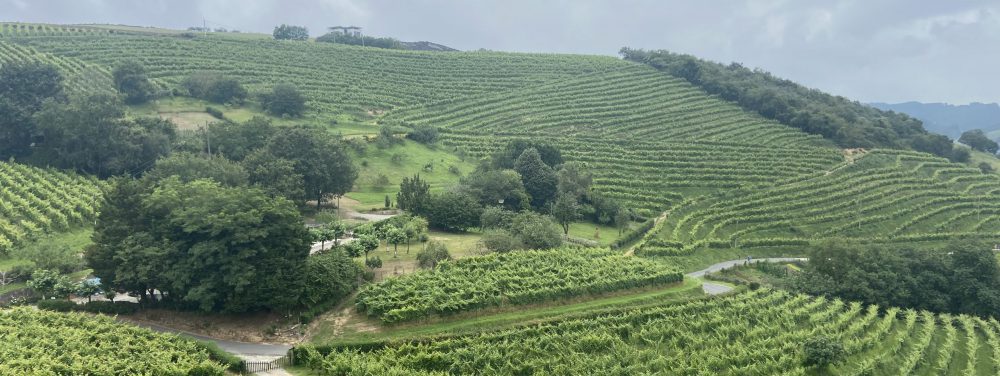After classes, the group split in half and separating the tour into two day, and came to Parte Vieja with hungry stomaches, ready to explore the most popular and famous pintxo bars in this part of the city. We meet in Haizea bar, a small crowded bar where everyone is shoulder to shoulder, as we learned is how pintxos should be eaten in our summer reading of Marti Buckley’s book.
Starting off with one of, if not the most, famous pintxos in San Sebastian, the Gilda. The Gilda, named after Rita Hayworth’s character in a movie that premiered the same year, is a simple three ingredient pinxto of guindilla pepper, anchovies, and olives, skewered onto a toothpick. A quick bite, sideways and slid off the toothpick, the Gilda offered a mouthful of salty, sweet, and slight acidic taste. This delicacy was followed by Brick de Bacalao, a cod dish beautifully presented on a plate with a creamy texture and a crunchy crust; so good that a few burned their tongues on the steaming dish not wanting to wait for it to cool. We were surprised to find that it lacked any fishy taste or smell, creating a savory, melt in your mouth, feeling. Some of the group decided to pair these two first pintxos with a glass of vino blanco (white wine) which went well with the two.
Moving into the busy labyrinth of Parte Vieja, we try pintxos outside an extremely crowded bar, Borda Berri. This stop included pintxos such as salmorejo with cottage cheese and sardines, which was a favorite of many in the group, and beef cheek cooked in red wine that pulls apart easily and was very tender.
We walked again until we reached Txepetxa, a bar famous for their anchovies. Being a family owned bar, this famous recipe for their anchovies is still only known by the mother and son, and will remain a secret as the only place it is written down is locked in a safe box. We got the chance to try these famous pintxos on this tour. We were each served two bread pintxos topped with the anchovies, one with peppers and one with crab. These seafood pintxos were a personal favorite, as well as a favorite or multiple people in the group.
We briefly stopped as a small butcher-like shop, selling pork, as well as other cooking ingredients and a wall of wine bottles. Here, we were able to taste the difference between a two porks: one which had a pure acorn diet for the last six months of its life, and one which was not pure. While both samples were delicious and salty-sweet, they both had distinct flavors and textures. The group was split between which was better, but it’s the opinion of many that the pure acorn died porn is of the higher quality.
We finish the tour at Ganbara; usually a very long line, the wait was surprisingly short for such a famous bar. We had several pintxos here, only some being a plate of delicious mushrooms and a skewered pintxo with monkfish. We ate, despite being full already, and were happy to try every food. We ended with, of course, dessert; a necessity for the sweet tooth. Torrija was a delicious treat that was hot and sugary, served with a scoop of vanilla ice cream, creating a rich and creamy dessert.
While we ate and had fun, we also learned much about the culture around pinxtos and city life in San Sebastian. We were elbow to elbow with each other, a far cry from the personal space we’re used to, and yet still enjoying the moment with delicious and quick bites, as well as talking and enjoying each other’s company. We learned about the detailed history of not only the food we ate but also the bars and restaurants that served them. Establishments passed down from generations, world class cooks, pintxo award winners, and much more. While we mostly stayed together, we saw the true way of eating pintxo was to be social, talking to many and meeting new people. We carried this into the night when many of us went to Pintxo Pote, an event where multiple bars had a drink and pintxo for around three euros. With the Lacunza school, we all spoke and got to know people we have never talked to as well as our friends.
For several of us on this trip, the pinxto tour was one of the biggest steps in immersing ourselves into the culture of San Sebastian. With full stomachs and light hearts, we continue to explore and learn more about day to day life in this beautiful city, and experience all it has to offer us. At home, we’ll be able to tell everyone about our experience and how the pintxo culture works, bringing people together to enjoy a bite and a drink after work, or even just to go out and socialize.
